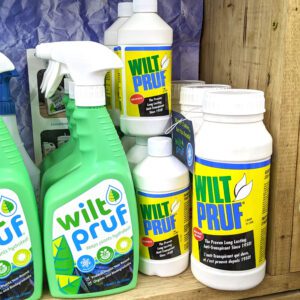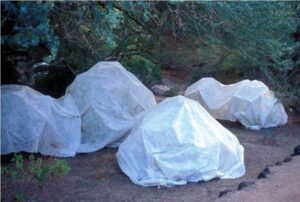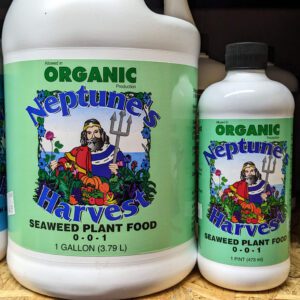When winter temperatures quickly drop below 32F, particularly if it has been dry, this can be incredibly stressful on plants, to the point of causing serious damage and even death to plants – especially those in containers. The bigger the drop in temperatures, the more stressful it will be on plants.
All parts of the plants can be impacted, from flower buds to leaf tips down to the roots. Existing leaves may turn brown and fall off. Trunk bark can split open as the water inside the plant freezes and swells -this kind of damage can kill plants.
Cold damage may not fully reveal itself until spring. For the damage that is quickly apparent, refrain from pruning until the warm days of late spring to early summer. The already damaged material can help provide protection for future cold snaps.
Here’s some steps you can take to protect your plants:
1. Group your container plants together, preferably up against a building.
2. Deeply water all the plants so they are well hydrated.
3. Surround the group with bags of mulch, straw, or leaves.
4. Apply Wilt pruf or diluted Neptune’s Harvest Seaweed to provide natural plant-based cold protection right BEFORE the temperatures drop below freezing.

5. You can use strands of incandescent outdoor Christmas lights draped throughout the plants, being careful that the bulbs themselves are not directly touching any parts of the plant.
6. Heat tape can also be wrapped around pots themselves, but be sure to remember to disconnect it once temperatures rise.
7. Cover the entire group with Reemay / row cover from the top of the plants down to the ground, careful to not let the Reemay actually touch the plants. We also carry flexible Fiberglass rods to ‘float’ the Reemay over the plants.

Aside from those in containers, certain plants may be more sensitive to this sudden change and will greatly benefit from protection, such as Camellias, Figs, Hollies, Magnolias, and Schip Laurels. Any plants you might be “zone-pushing” these past few years, such as trying to grow zone 7b or zone 8 plants here in the ground will need as much protection as possible.

Long Term Prevention
You can help mitigate issues with suddenly plummeting temperatures in several ways.
- Choosing plants native to WNC – plants adapted to this region are an excellent option.
- Know your microclimate – you may have several microclimates on your property. Areas up against buildings, rock walls, next to ponds, and behind windbreaks are generally milder and more protected, and therefore a good option for more cold sensitive plants. South-facing properties tend to be warmer in the daytime but will still get cold, subjecting plants to more temperature fluctuations. North-facing properties tend to be more evenly cool to cold. Learning your microclimates can help you make the best choices for where to place your plants.
- Avoid fertilizing with fertilizers high in Nitrogen in the fall. High levels of Nitrogen can cause fresh new tender growth late in the season, this growth is particularly susceptible to cold damage (however fall is an excellent time for fertilizers higher in Phosphorus, such as Rock Phosphate).
*If you do nothing else, deeply WATER YOUR PLANTS before the cold arrives.*
This will help to prevent damage from desiccation, a common issue in winter.
Don’t forget to disconnect and drain your hoses, turn off water to outdoor spigots, and let those indoor faucets drip when temperatures are below 32F. The water can be captured with watering cans and used for indoor plants and other purposes.

